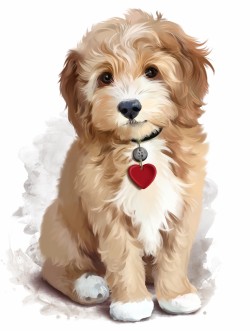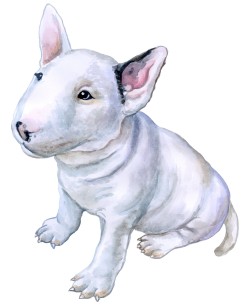Perfect Puppy Manners: Just 23 Steps
By Michele Welton, Dog Trainer, Breed Selection Consultant, Author of 15 Dog Books
The easiest way to train your puppy is to establish choreographed routines – same things, same order, same words – with yourself as the director, the one in charge. Create good routines, stick to them, and your pup's behavior will be predictable and good.
 When your puppy does something you don't like, say "No" or "AH-ah" along with a corrective technique that discourages him from repeating that behavior.
When your puppy does something you don't like, say "No" or "AH-ah" along with a corrective technique that discourages him from repeating that behavior.- When your puppy does something you do like, let him know by saying, "Good" or "Yes" along with a reward that encourages him to repeat that behavior.
- Indoors, require calm behavior. Pups who are allowed to be excitable indoors are far more likely to have behavior problems. Don't allow running around the house, rough play, barking, jumping, rushing the doorbell, or attacking the vacuum cleaner. If necessary, have the pup wear his leash indoors so you can stop those behaviors.
- Whenever your puppy is on leash, he must walk without pulling. If he is currently pulling on the leash during walks, don't go for any more walks until you've taught him to stop pulling in your own home and yard.
- Teach him to go into his crate or pen and to stay there quietly, with no excitability or barking.
- Teach your puppy to wait at open doors or gates, for your permission to go through. It's a subtle way to get him looking to YOU for guidance and direction.
- Teach your pup to go to his dog bed when told and to stay there until given permission to get up. This valuable exercise teaches calmness, impulse control, and physical and mental relaxation. Every pup should be able to do it.
- Teach your pup to come when called – every time. For now, that might mean keeping him on a leash in the house and a long cord in the yard, so you can get hold of him to make sure he comes.
- Make sure he takes food and toys gently from your hand – no grabbing.
- When you prepare his meals, keep him in the kitchen with you. You want him to see that his food comes from you. Don't let him race around or bark. He should wait politely. Have him Sit before you place his bowl on the floor. To discourage picky eating, give him 10 minutes to eat, then pick up his bowl.
- If he has any behavioral issues, he should not be allowed on furniture unless invited up. Sleeping on human beds or furniture is a privilege that must be earned.
- Don't let your pup demand lots of petting and attention. This can create psychologically unhealthy (bossy or needy) dogs. You decide when to pet and when to stop. That's enough is an important lesson for all puppies to learn.
- Stop all mouthing or nipping at anyone's hands or feet.
- Barking makes dogs more excitable. Don't allow your puppy to bark at harmless things such as your neighbor or your neighbor's dog. Certainly he can bark to alert you to something, but he should stop barking when told. He should be quiet when left home alone.
- Don't allow jumping on anyone, including yourself.
- Don't allow your puppy to "rush the doorbell", i.e. pitch a fit when someone comes to the door.
 Make sure your pup will move out of your way when told.
Make sure your pup will move out of your way when told.- Teach your puppy to sit and stay sitting until you cue him to get up.
- Don't let your puppy fuss when you're brushing him, bathing him, clipping his nails, or brushing his teeth. Teach him to accept handling of any part of his body.
- Teach your pup to give or drop whatever is in his mouth when told.
- Begin a proven housebreaking program where your puppy can only go to the bathroom in the right place.
- Make sure your pup interacts with people and other animals politely, or else ignores them. Don't allow him to act fearfully or aggressively toward anyone.
- Make sure your pup is respectful of your children, and other dogs and cats in your family. No pestering, pushiness, or jealousy.
If you follow my training program, your pup should grow up being able to do everything in the list above.
You can start teaching these skills at any age.
Just don't expect quick results in pups under 10 weeks old. With these canine infants, focus on calmness indoors, mouthing/biting, crate training, potty training, and introducing the leash.
You can teach those skills in any order.
I teach whatever happens to come up during the day. But if your pup isn't 100% housebroken, start there.
You don't need to teach just one thing at a time.
For example, you can introduce "Good and "No", being quiet in the crate, walking on a leash, come when called, wait at the door, and so on. As you read each chapter, implement the routines and techniques in that chapter as soon as possible.
It's easier to train a dog if your other dogs are already well-behaved.
If your other dogs have behavioral issues, if they sometimes listen and sometimes not, or if they're not 100% housebroken, a puppy is likely to follow their unruly behaviors. Your misbehaving dogs should really have been trained before you brought another pup home. Now all you can do is try to train them all now. Certainly do-able, but obviously more work!

It's easier to train a puppy when you're home most of the day.
- First, because dogs are social animals who want to be close to their family during the day. When a pup's social needs are being met, training is easier.
- Second, when you interact with your puppy frequently throughout the day, these micro-interactions give you the chance to respond to everything the pup does. The more frequently you can do this, the faster the puppy learns.
But if everyone works or goes to school, you can't reward good behavior or correct bad behavior. The longer a bad behavior goes without correction, the more habitual it becomes. And when someone finally does come home, the pup races around with wild excitement. It's harder to encourage calmness in a lonely, bored pup whose social needs are not being met.
It's easier to train a puppy who is getting enough exercise.
Dogs are active, bright animals. If they don't have anything to do except wander aimlessly around the yard, they feel bored and frustrated. Pups vent their boredom and frustration by destroying things, barking, or being rambunctious.
It's harder to make a dog conform to your expectations when his needs aren't being met. Yes, of course you need to stop him from destroying things and barking, but you must also add more exercise and interesting activities to his life.
It's easier to train some breeds than other breeds.

Someone who has never trained a dog before will find it easier to train the average Golden Retriever or Sheltie or Poodle, compared with the average Basenji or Shiba Inu or Bull Terrier.
Make use of the breed reviews on my website. A challenging breed is definitely trainable, but you'll need to put in more time and effort.
It's easier to train a puppy when you use a balanced training method.
Balanced Training is the time-honored training method that rewards good behavior AND corrects bad behavior. This clearly communicates to your puppy what you want him to do and not do. It's sensible, fair, and easy to understand – the perfect training method for dogs.
It's easier to train a puppy when you teach ALL the skills....
....rather than cherry-picking some and blowing off the rest.
For example, you might be tempted to focus on commands (such as "Come") while still allowing your pup to race around indoors, bark at visitors, jump on people, demand petting and attention, and pull on the leash.
That's not likely to work. Allowing excitable, impulsive, or disrespectful behavior keeps a puppy in an excitable, impulsive, and disrespectful mindset. This state of mind is stressful for a puppy to live with and virtually guarantees more behavior problems in the future.
So commit to working on each skill on the list. They're all important in encouraging calm and respectful behavior and discouraging excitable and disrespectful behavior. Follow my articles faithfully and the result will be a calm, well-behaved pup who loves, trusts, AND respects you.
My best-selling books – now available FREE on my website
 Respect Training For Puppies: 30 seconds to a calm, polite, well-behaved puppy is for puppies 2 to 18 months old. Your puppy will learn the 21 skills that all family dogs need to know. Click here to read for free.
Respect Training For Puppies: 30 seconds to a calm, polite, well-behaved puppy is for puppies 2 to 18 months old. Your puppy will learn the 21 skills that all family dogs need to know. Click here to read for free. Teach Your Dog 100 English Words is a unique Vocabulary and Respect Training Program that will teach your adult dog to listen to you and do what you say. Click here to read for free.
Teach Your Dog 100 English Words is a unique Vocabulary and Respect Training Program that will teach your adult dog to listen to you and do what you say. Click here to read for free. 11 Things You Must Do Right To Keep Your Dog Healthy and Happy helps your dog live a longer, healthier life. Get my honest advice about all 11 Things before you bring home your new puppy, because some mistakes with early health care cannot be undone. Click here to read for free.
11 Things You Must Do Right To Keep Your Dog Healthy and Happy helps your dog live a longer, healthier life. Get my honest advice about all 11 Things before you bring home your new puppy, because some mistakes with early health care cannot be undone. Click here to read for free.
